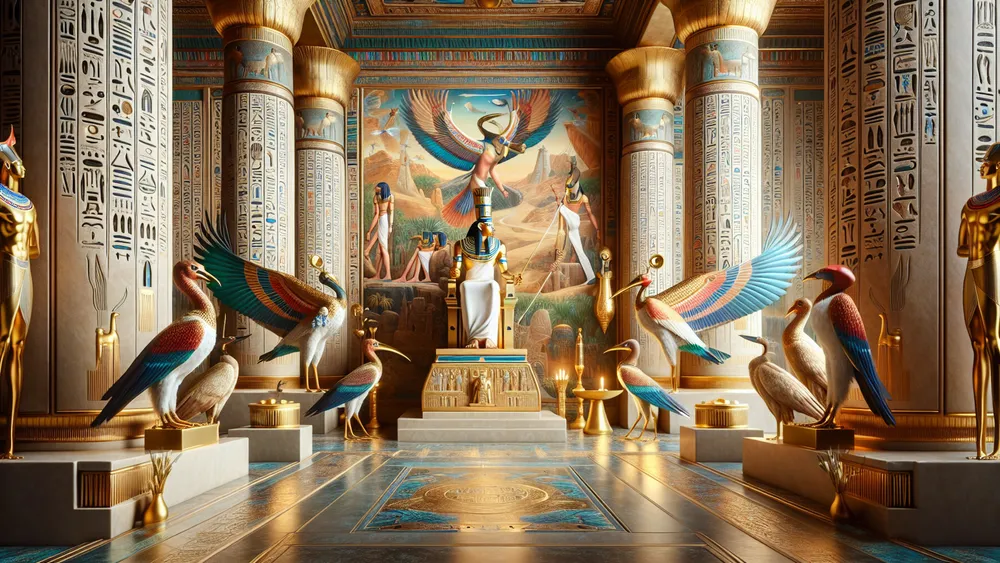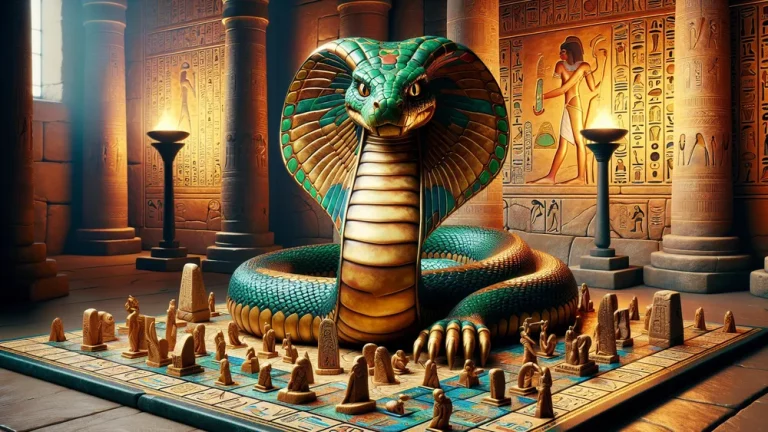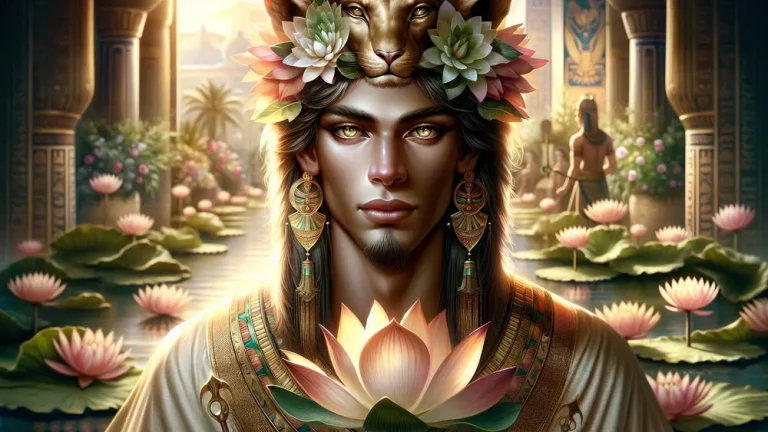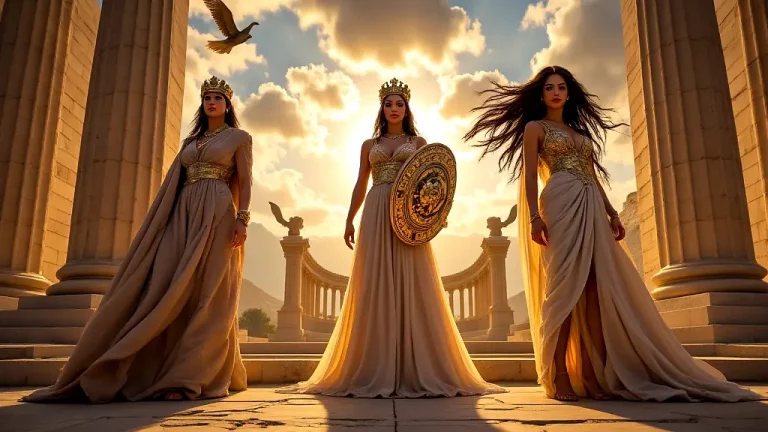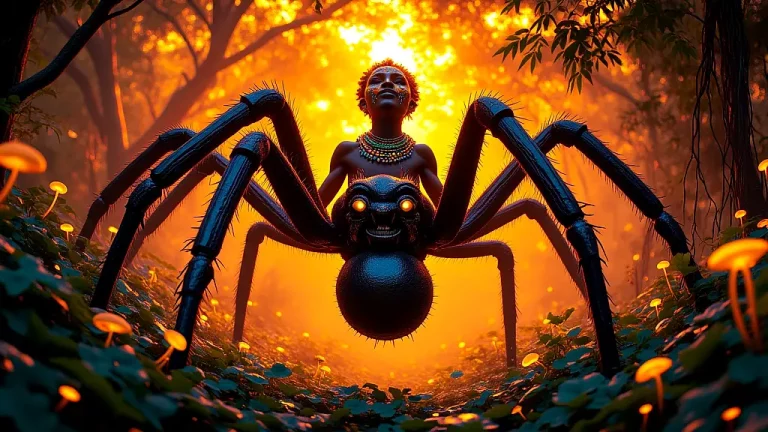Birds In Egyptian Mythology: Deities And Symbolism
Humans really liked birds a lot through time, and in the old Egyptian stories, birds did have a very special place. Many might be surprised that birds were admired not just for their songs or looks, but seen as strong symbols of power that is divine and offers protection. Just as the eagle shows freedom and strength today, birds in old Egypt, they were very much tied to gods and every day.
Key Points:
- Birds in ancient Egyptian mythology were seen as symbols of divine power, protection, and connections to the sky.
- Important bird gods included Horus (falcon), Thoth (ibis), Bennu (heron/phoenix), and Nekhbet (vulture), each with unique roles and meanings.
- Birds played vital roles in religious practices like offerings, mummification, and symbolism in temples and tombs.
- Birds represented royalty and power, with symbols like the falcon and vulture linked to kingship and protection.
- Bird imagery in Egyptian art and buildings showcased their significance in cultural and religious beliefs.
- Stories of bird gods like Horus, Thoth, Bennu, and Nekhbet reflected themes of rebirth, wisdom, protection, and creation.
- Birds were integral to Egyptian burial practices, with mummified birds and bird-related items aiding the deceased on their spiritual transition.
In this writing, we will look at many roles birds did play in Egyptian stories. Starting with the falcon-headed Horus, who did show kingship and gave protection, to ibis-headed Thoth, who was the god of wisdom and writing, each of these bird gods had different traits and meant much. We will see how birds got into daily living and practices in religion, even shown in art and used in burial ways.
At the end, you will see why birds were important to ancient Egyptians and how their symbols still matter today.
Birds In Egyptian Mythology: Overview and Key Facts
| Main Point | Details |
|---|---|
| Meaning | Birds were seen as symbols of divine power, giving protection, and connected to the sky. Because they fly, they were linked with gods and the afterlife. |
| Gods | Some main gods were shown with bird traits, like Horus (falcon), Thoth (ibis), Bennu (heron or phoenix), and Nekhbet (vulture). Each one had its own roles and meanings. |
| Religious Things | Birds were important in religious acts, including offerings and wrapping bodies. Bird images were everywhere in temples and tombs, showing different life and afterlife ideas. |
| Culture | Birds affected art, buildings, and symbols for kings. They were in crowns, charms, and other power symbols, showing strength and safety. |
| Everyday Life | Birds were part of daily living, even outside religion. They were pets, hunted for meals, and watched for signs from gods. |
| Stories | There are many myths and legends with birds, showing their place in stories of world beginnings, rebirths, and godly actions. |
| Burial Ways | Birds were important in burial traditions, with bird mummies and images used to make sure there was a safe journey to the afterlife and safety in tombs. |
Why Birds Mattered to the Ancient Egyptians
To grasp the big importance of birds in old Egyptian culture, we should look at their meanings in symbols and everyday jobs in stories and daily life. It’s essential, you see.
Birds as Signs of Godly Power and Safety
In old Egyptian stories, birds were seen as strong signs of godly power and safety. It might be interesting to know that their flying high above the ground was viewed as connecting directly to the sky, and this made them messengers of gods. This link to the sky and the godly places filled birds with an idea of importance and power. For instance, the falcon, many times related to the god Horus, showed kingship and safety, while the ibis, connected to Thoth, showed wisdom and knowledge. Birds were thought to have traits making them best symbols of godly power and safety, such as:
- Flying: Showing freedom and the ability to go beyond ground limits.
- Sharp Eyesight: Showing understanding and seeing more than what’s close.
- Making Nests: Reflecting ideas of safety, caring, and life cycles.
Such traits made birds very important in the spiritual and religious life of Egyptians back then, acting as reminders of the divine presence and safety in their world.
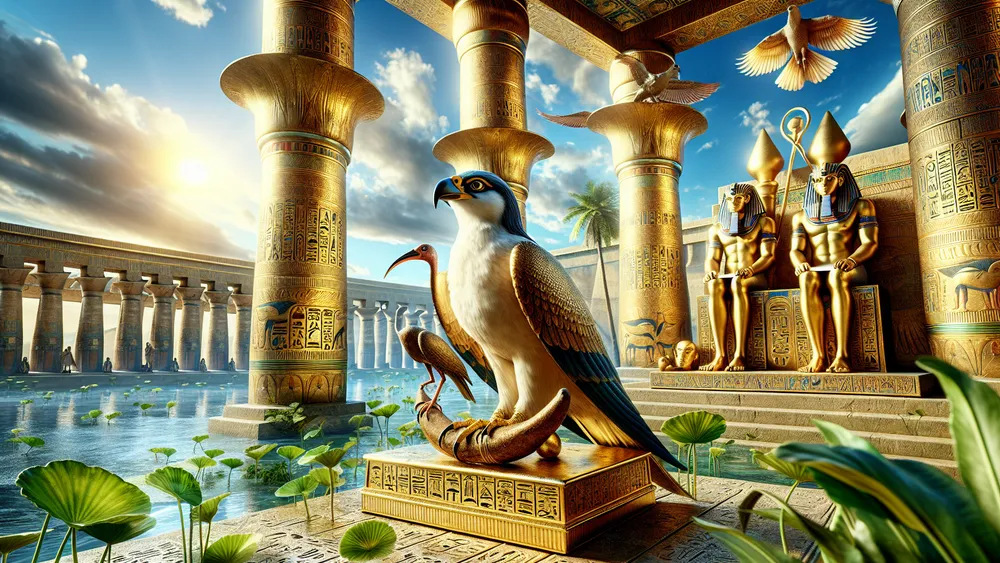
Birds in old Egyptian culture were seen as powerful symbols of godly connection and safety due to their traits like flying, sharp eyesight, and nest-building, which represented freedom, wisdom, and care, making them essential in spiritual and religious beliefs.
Birds in Everyday Egyptian Life and Religion
In old Egyptian daily life, birds had many roles, much more than just being admired. You might find it interesting that birds were very important in religious rituals and things given to gods, often being seen as go-betweens for humans and gods. For example, people often made birds into mummies and gave them to gods out of respect. This is similar to how nowadays people keep important things to respect their past. Bird images were often seen in temples and tombs, showing different parts of life and death. Specific practices included:
- Bird Mummies: Birds were carefully made into mummies and put in tombs to go with dead people in the afterlife.
- Temple Art: Birds were shown in religious carvings and paintings to bring protection and godly favor.
- Giving Offerings: Birds were killed and given to gods during ceremonies to get their blessings.
These things show the deep link between birds and the spiritual life of old Egyptians, showing their importance in daily and holy activities.
Big Bird Gods and Goddesses in Egyptian Myths
Now that we looked at the everyday importance of birds in ancient Egypt, now, let’s look into the big gods and goddesses tied to these great creatures and their roles in stories.
Horus: The Falcon God
Horus, the god with a falcon head, is one of the most important gods in Egyptian stories. You might be interested to know that Horus’s story is deeply connected with the story of his parents, Osiris and Isis. In the tales, Horus was born to get revenge for his father Osiris’s death caused by his uncle Set.
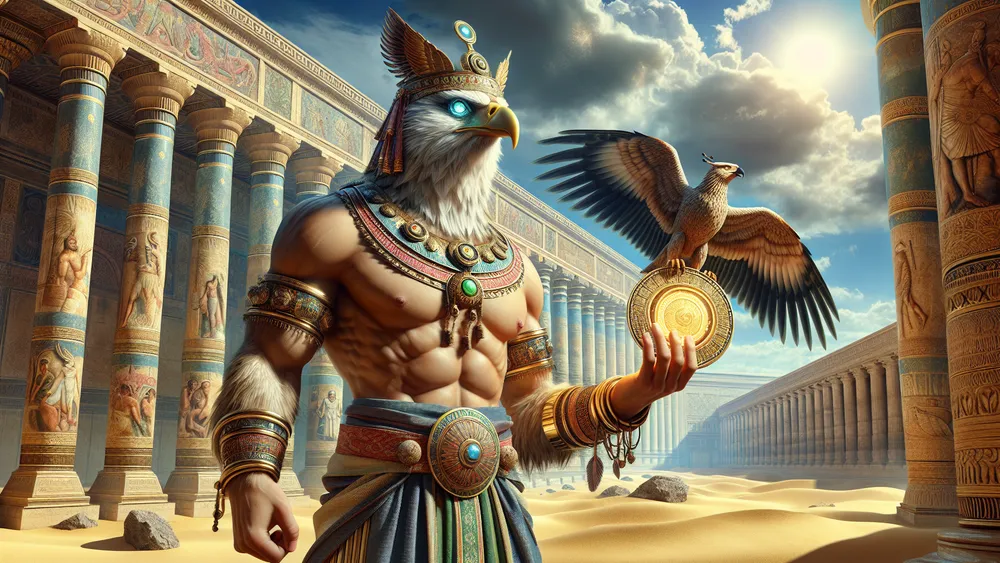
This big battle between Horus and Set shows the never-ending fight between good and bad. Horus’s win not only got revenge for his father but also made him a symbol of justice and right kingship. People believed his eyes represented the sun and the moon, making sure of his role as a sky god.
Horus’s importance is not only in stories but also in the areas of the sky, war, and hunting. Believed to rule the heavens and protect Egypt, he was the god of the sky. His link with war and hunting made him a patron of warriors and hunters, showing power and courage. Most importantly, Horus was closely connected to the pharaohs, who were seen as his living forms on earth. This supported the divine right of kings to rule. The symbols and things linked with Horus include:
- The Eye of Horus: A sign of protection, royal power, and good health.
- The Falcon: Showing his rule over the sky and his sharp vision.
- The Double Crown: Showing his rule over both Upper and Lower Egypt.
- The Ankh: Meaning life and never-ending life.
These signs show Horus’s many roles in Egyptian religion and his long-lasting legacy as a protector and ruler.
Thoth: The Ibis-Headed God of Smarts
Thoth, the god with an ibis head, has a significant spot in Egyptian stories as the god of wisdom, writing, and knowledge. You might like to know that people thought Thoth made writing and hieroglyphs, making him the god for scribes and smart people. Stories about Thoth often show him as a helper and a smart advisor to the gods, mainly in the fights between Horus and Set.
Thoth’s smarts were matchless, often shown holding a scribe’s palette and reed pen, showing his job in writing down the knowledge of the gods and people.
His link to the moon also shows his importance. Often shown with a moon disk above his head, showing his tie to the moon and its cycles. This also ties him to time and the control of sky events. In the world after death, Thoth had a key job in judging the dead. He wrote down the results of the weighing of the heart ceremony, where the dead person’s heart was weighed against Ma’at’s feather, the goddess of truth and fairness. The symbols and things linked with Thoth include:
- The Ibis: Showing his smarts and link to the gods.
- The Scribe’s Palette and Reed Pen: Showing writing and knowledge.
- The Lunar Disk: Showing his link to the moon and time.
- The Scales of Justice: Showing his job in judging the dead.
These symbols show Thoth’s many roles in Egyptian religion, focusing on his contributions to wisdom, knowledge, and the afterlife.
Bennu: The Rebirth Phoenix
Bennu, shown as a bird like a heron, is a vital part in Egyptian stories linked to creation and rebirth. It might be interesting to know that Bennu was thought to have had a big role in making the world. In the old stories, Bennu came out from the first waters called Nun and sat on a rock, starting time.
This creation act is reflected in the bird’s link to the sun god Ra, with Bennu being seen as a part of Ra’s soul. The bird’s repeating renewal, like the sun rising and setting, shows the never-ending cycle of life, death, and rebirth.
The idea of Bennu also links to everlasting life. Just like the sun comes up every day, Bennu’s story cycle of dying and coming back to life shows the idea of living forever. This idea is similar to the Greek bird called the Phoenix, which comes back from its ashes. To show you the likenesses and differences between these two myth birds, here’s a comparison:
| Attribute | Bennu (Egyptian) | Phoenix (Greek) |
|---|---|---|
| Origin | Came from old waters of Nun | Came back from its ashes |
| Association | Sun god Ra | Sun and fire |
| Symbolism | Making, rebirth, forever life | New life, living forever |
| Depiction | Bird like heron | Bird like eagle with bright feathers |
| Role in Stories | Started the beginning of time | Symbol of coming back and new life |
This table shows how both Bennu and Phoenix hold ideas of coming back to life and living forever, though their story contexts and cultural meanings are not the same.
Nekhbet: The Vulture Goddess
Nekhbet, the vulture goddess, has an important place in Egyptian stories as the guardian of Upper Egypt. It is interesting to know that Nekhbet was often shown as a vulture spreading her wings over the pharaoh, creating protection around him. Her link with motherhood and protection is clear in her job as a guardian of the king and the nation, much like a mom taking care of her children. In royal clothes, Nekhbet was often shown wearing the white crown of Upper Egypt, showing her protective job over the area. The things connected with Nekhbet include:
- The Vulture: Showing protection and motherly care.
- The White Crown: Showing her guardianship over Upper Egypt.
- The Shendyt (Royal Apron): Connecting her to royalty.
- The Ankh: Meaning life and protection.
These things show Nekhbet’s many roles as a protector and mother figure in Egyptian stories.
Nekhbet, the vulture goddess, symbolizes protection and motherly care in Egyptian mythology through her role as the guardian of Upper Egypt.
Birds’ Symbolism and Their Cultural Impact
By looking more closely at the importance of birds in old Egypt, you may find how these bird symbols spread through different parts of Egyptian life and thoughts.
Birds Representing Royalty and Power
In old Egypt, birds were strong signs of royalty and control, often used to show the kings’ divine right and their link to the gods. It might surprise you to learn that bird pictures were mainly found in royal symbols, crowns, and other power signs. For instance, the falcon, showing the god Horus, was a common design on the pharaoh’s crown and meant protection and kingship. Similarly, the vulture, connected to the goddess Nekhbet, was often shown on the headdresses of queens and royal mothers, showing their protective role over the nation. Here are some examples of bird signs in royal uses:
- The Falcon: Sign of Horus, showing kingship and divine protection.
- The Vulture: Sign of Nekhbet, showing motherly protection and guardianship.
- The Bennu Bird: Linked to Ra, showing rebirth and eternal life.
- The Ibis: Linked to Thoth, showing wisdom and knowledge.
These bird signs were not just decorations but had deep meanings that strengthened the pharaoh’s divine control and the protective power of the gods.

Birds in Burial Practices and Afterlife Beliefs
In old Egyptian burial practices, birds had a significant role in showing the soul’s journey to the next life. It is interesting to know that bird mummies, especially ibises and falcons, were often put in tombs as gifts to the gods, believed to help make sure safe passage and protection for the dead. Bird pictures were also common in tomb decorations, with scenes showing birds in flight, which showed the soul’s rise to the skies. These practices show the deep link between birds and the next life in Egyptian ways of believing. Here are some examples of bird-related burial items:
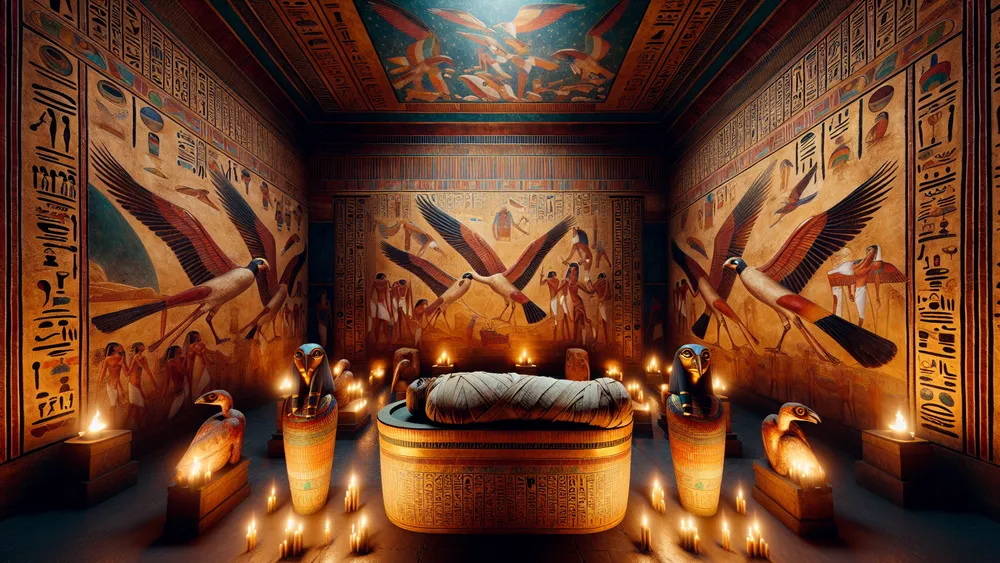
- Ibis Mummies: Linked to Thoth, showing wisdom and help in the next life.
- Falcon Mummies: Linked to Horus, showing protection and kingship.
- Bird Amulets: Used to protect the dead and make sure rebirth.
- Tomb Paintings of Birds: Showing the soul’s journey and the presence of divine protection.
These items show the importance of birds in making sure a successful transition to the next life, reflecting the Egyptians’ deep respect for these creatures.
Birds in Egyptian Art and Buildings
Birds were a main feature in Egyptian art and buildings, which show different holy and natural things. You may find it interesting to see how bird designs were in detail carved into temple walls, painted in bright colors on tombs, and made into statues, each having a symbolic meaning. For instance, the falcon, meaning Horus, was often shown in temple carvings to mean protection and holy kingship. Also, the ibis, which is connected to Thoth, was often in paintings and sculptures to show wisdom and knowledge. These artistic pictures were not just decorations but had deep meanings that supported the cultural and religious beliefs of the ancient Egyptians. Here are some examples of bird pictures in Egyptian art:
| Bird Symbol | Art Form | Location | Meaning |
|---|---|---|---|
| Falcon | Carving | Temple of Edfu | Protection and kingship |
| Ibis | Painting | Tomb of Horemheb | Wisdom and knowledge |
| Vulture | Sculpture | Karnak Temple | Motherly protection |
| Bennu Bird | Relief | Heliopolis | Rebirth and creation |
These examples show the key role of birds in Egyptian art, showing their deep cultural and religious importance.
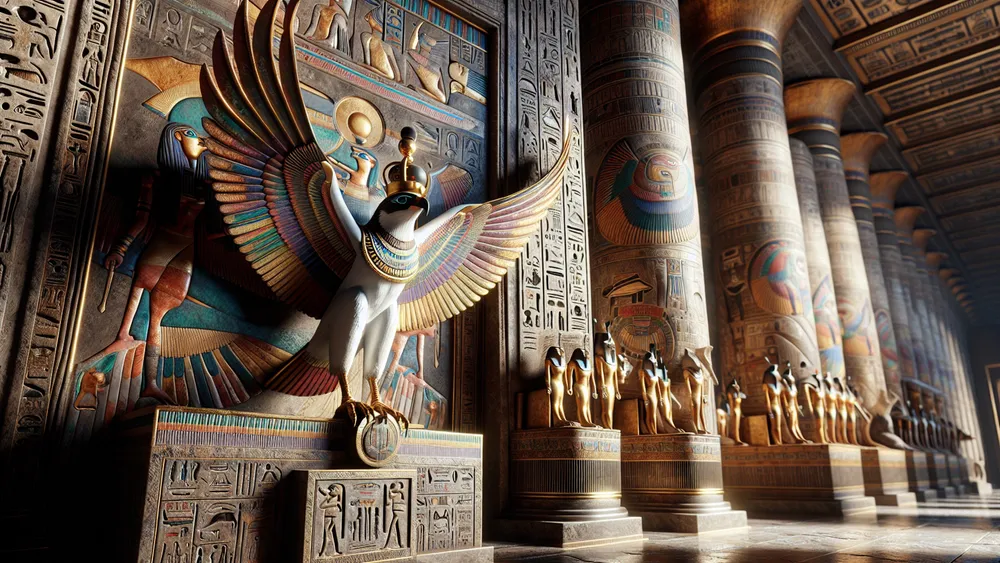
FAQs
1. Why Was the Falcon Important in Egyptian Myths?
The falcon was important in Egyptian myths because it symbolized the god Horus, representing kingship, protection, and the sky.
2. How Did Ancient Egyptians Use Birds in Religion?
Ancient Egyptians used birds in religion by incorporating them into rituals, offerings, and symbolic representations.
3. What’s the Link Between Bennu Bird and Rebirth?
The link between the Bennu bird and rebirth lies in its association with the sun god Ra and the concept of eternal life and renewal.
4. Why Was the Ibis Holy in Ancient Egypt?
The ibis was holy in ancient Egypt because it was associated with Thoth, the god of wisdom and knowledge.

